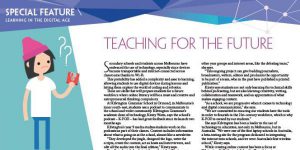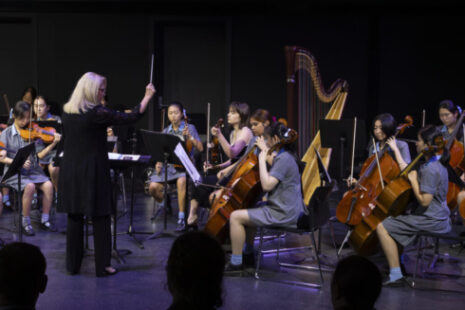Teaching for the future

Teaching for the future
Secondary schools and students across Melbourne have embraced the use of technology, especially since devices became transportable and internet-connected across classrooms thanks to Wi-Fi.
This portability has added a complexity and ease to learning, allowing students to use digital devices during lessons and letting them explore the world of coding and robotics.
These are skills that will prepare students for a future workforce where online literacy will be a must and creative and entrepreneurial thinking compulsory.
At Kilvington Grammar School in Ormond, in Melbourne’s inner south-east, students use a podcast to communicate to the school and wider community. Kilvington Grammar’s academic dean of technology, Kirsty Watts, says the school’s podcast – K-POD – has had great feedback since its launch two months ago.
Kilvington’s year 9 media studies students work on the podcasts as part of their classes. Content includes information about what is going on at the school, almost like a newsletter.
“They developed the jingle, designed the logo, write the scripts, create the content, act as hosts and interviewers, and edit all the audio into the final edition,” Kirsty says.
Year 9 students helped start the podcast, but Kirsty says many other students are keen to be involved. They have been exploring other ways K-POD might be used.
“Now the podcast is established, we are recruiting from other year groups and interest areas, like the debating team,” she says.
“This ongoing project can give budding journalists, broadcasters, writers, editors and producers the opportunity to be part of a team, who in the past have published a printed publication.”
Kirsty says students are not only learning the technical skills behind podcasting, but are also learning creativity, writing, collaboration and teamwork, and an appreciation of what makes engaging content.
“As a school, we are progressive when it comes to technology and digital communication,” she says.
“We are committed to ensuring our students have the tools in order to flourish in the 21st-century workforce, which is why K-POD is owned by our students.”
She says Kilvington has been a leader in the use of technology in education, not only in Melbourne, but in Australia. “We were one of the first laptop schools in Australia, a beta-testing site for the program dedicated to integrating the internet into schools, and we were Australia’s first wireless school,” Kirsty says.
While creating online content has been a focus at Kilvington, St Catherine’s School in Toorak is using augmented and virtual reality as part of its classes.
Head of digital learning and practice Alex Borlenghi says years 7 and 8 students are taking “virtual field trips” to see the pyramids in Egypt and visit Mount Vesuvius and Pompeii via VR headsets.
“It allows students to explore street by street, without having to physically leave the classroom,” Alex says.
Year 10 students learn history through augmented reality posters, which include embedded videos (in augmented reality, an image can be scanned with a mobile phone and information, video and/or links to websites will appear).
Just weeks ago, St Catherine’s also introduced a new elective for years 9 and 10 students – “the augmented and virtual world”. Alex says it is the first of its kind in Australia.
“It not only teaches our students to understand and use AR and VR, but to create in both media,” he says. As well as learning about how the technology works, virtual and augmented reality offer opportunities for students to learn in more hands-on ways.
“Using VR to virtually transport students to locations on the other side of the world opens up a huge variety of experiential learning possibilities. We can visit ancient monuments, some of the world’s great museums and natural environments,” Alex says.
“Students can look around them in all directions and even virtually ‘walk’ through the streets of a European city, hiking trail in the Rocky Mountains or a Moroccan souk.
“Augmented reality provides different opportunities. Teachers can add digital information to real-world objects and link them to online resources. Then students themselves can add a layer of digital information to an image, poster or object.
“When a World War II poster in a classroom can come alive and discuss the war with onlookers … it’s likely students are going to be pretty engaged with their learning,” Alex says.
https://www.theweeklyreview.com.au/learn/melbourne-schools-high-tech-learning/





